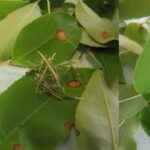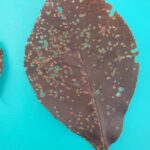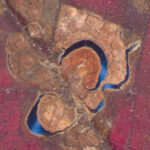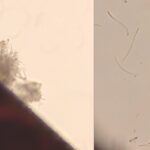Cherry, plum, almond, peach and cherry laurel all get a common issue called shot hole leaf spot. At first, a chlorotic or necrotic spot develops on the foliage (Figure 1). When a tree has severe symptoms, the leaves may drop prematurely from the tree. If the leaves remain on the tree, the leaves produce a cork layer around the leaf lesion, sometimes a few millimeters beyond the edge of the necrotic tissue. This layer causes the inner tissue to separate and fall out, leaving round to irregular holes in the leaf. The name of the disease, shot hole leaf spot, refers to the holes in the foliage as if the leaves were shot with a gun.
Determining a shot hole problem is present is fairly easy, however, there are multiple things that can cause these symptoms in Prunus, including fungi (Stigmina carpophila and Blumeriella jaapii), bacteria (Xanthomonas arboricola pv. pruni), viruses (Prunus necrotic ringspot virus and Cherry necrotic rusty mottle virus), and injury (chemical damage, including contact burn from fungicides and herbicides). In most cases, no management is necessary since the damage is usually minor or doesn’t cause severe defoliation. However, in cases where significant leaf drop is observed, having the cause identified is important to apply the appropriate management strategy when it comes to pathogens.
On samples that come to the lab, the most common cause of shot hole leaf spot is the fungus Blumeriella jaapii. The necrotic leafspots that the fungus causes are fairly small, but they can create larger areas of necrotic tissue as they coalesce, making the leaf look like Swiss cheese (Figure 2, 3). Under humid and warm conditions, the fungus will produce asexual spores from fruiting structures on the leaf undersides. These are usually at the dead center of the individual round leaf spots. Spores that have a white appearance will ooze out of the leaf where it can be spread by water splash (Figure 4, 5).
It is good practice to remove affected leaves, whether they fell during the season or in the Fall, to reduce the amount of inoculum next spring. If you know that particular trees may have more severe leaf spot issues, fungicide applications can be made to protect expanding foliage from infection. For fungicides that are labeled for Blumeriella, please see the Purdue Plant Doctor Link Below.
Please remember that fungicides will have no effect on bacteria (or viruses, or abiotic issues for that matter). Having the correct cause identified is important for management. If you send a sample to our lab for diagnosis, we will need leaves with intact leaf spots in order to attempt an identification.
Cherry Leaf Spot: Blumeriella jaapii
https://www.purdueplantdoctor.com/factsheet/tree-578
Shot hole disease (particularly Xanthomonas)*
https://fff.hort.purdue.edu/article/shot-hole-disease/
*Please note that any pesticides mentioned are for orchard use. Always read and follow the label for any pesticides to ensure that they are being applied safely and in the conditions outlined by the label. Remember, the label is the law.
Symptoms and Signs for Plant Problem Diagnosis – An Illustrated Glossary
Shot Hole symptom description: Page 52
https://www.extension.purdue.edu/extmedia/BP/BP-164-W.pdf
- Figure 1 Symptoms of shothole leaf spot. No pathogen was found
- Figure 2 Shot hole leaf spot caused by Blumeriella jaapii, creating numerous leaf spots.
- Figure 3 Caption: Close-up image of multiple lesions coalescing and creating larger areas of dead tissue on the leaf.
- Figure 4 Caption: Leaf underside showing sporulation of Blumeriella jaapii. Spores are white in color and can be found near the center of the leaf lesions.
- Figure 5 Microscopic images of Blumeriella jaapii spores: Lefthand side shows clumps of spores exuded from the cut leaf tissue; right hand shows individual spores, which are long and thin.




